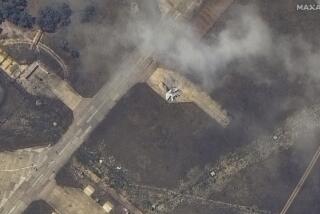NEWS ANALYSIS : Buffer Zone Is Considered to Thwart Hussein
- Share via
WASHINGTON — As pressures mount for a new strategy to ensure that this Iraq crisis is the last, the Clinton Administration may finally have to answer the central question left open by the George Bush Administration: what to do about Iraqi President Saddam Hussein?
To prevent the possibility of repetitive crises and revolving-door military deployments, military planners now face the complex issue of Iraq’s cunning leader and his future.
“It’s time to get rid of him. Even if his ability to attack Kuwait is eliminated, he’s still a menace to the region,” said Laurie Mylroie, author of two books on Iraq and a research fellow at the Foreign Policy Research Institute in Philadelphia.
Most available mechanisms for punishment, from economic sanctions and political isolation to military devastation, have been tried since 1990--with marginal impact on Hussein’s rule.
As a result, Persian Gulf War allies, U.S. analysts and pivotal U.N. members are now debating options rejected four years ago for fear of a result even more ominous than Hussein’s political survival: the fragmentation of Iraq.
High on the list of new possibilities is the creation of a zone in southern Iraq where Iraqi military forces would be excluded or their presence would be severely limited. With most of northern Kurdistan already beyond Hussein’s control, that would effectively leave Hussein in full charge only of the central third of his country.
During Secretary of State Warren Christopher’s visit to the region today, Kuwait will press the case for an exclusion zone as the only means of both constraining Hussein militarily and promoting political conditions to foster challenges to his rule.
If the southern zone was large enough and the military presence sufficiently limited, dissident political activity could spring up and lead to a form of alternative local power, as has occurred in the north.
“This time, the goal has to be to figure out a long-term deterrent on Saddam and to make him understand he faces serious punishment if he engages in unacceptable behavior,” said Phebe Marr, Iraq specialist at Washington’s National Defense University. Creating an exclusion zone “would certainly do that,” she said.
An exclusion zone was seriously considered after the 1991 Gulf War. Former U.S. Ambassador Thomas R. Pickering had mobilized consensus for it at the United Nations.
But over strong objections from Pentagon officials, Gen. H. Norman Schwarzkopf vetoed the idea because of concern about the complexities of administering the southern border area and because he believed that it had “no military value,” according to former Bush Administration officials.
There were also concerns about breaking Iraq into three pieces based on the major ethnic and religious groups in northern Kurdistan, the Sunni-ruled center and the Shiite-dominated south. Iraq’s dismemberment or instability was viewed as a threat to all its neighbors, many of whom also have simmering ethnic or religious divisions.
The growing consensus behind a southern exclusion zone, which the United States is now floating at the United Nations, reflects the burden of Hussein’s ongoing rule over the intervening period.
The idea of a zone is “almost a must,” former Undersecretary of Defense for Policy Paul Wolfowitz said Tuesday. “We should not talk about the notion that he can comply with U.N. resolutions and then get his power back,” Wolfowitz said. “As long as people think he has a future, he may have one.”
But even if the idea of an exclusion zone becomes policy, many issues still have to be decided, including the size of the area, the terms of exclusion and the means of enforcement.
In terms of size, the largest area under consideration begins at the 32nd Parallel and would include several Iraqi cities such as Basra and Najaf, as well as vital oil-producing areas. The smallest area would be the largely barren desert area just north of Kuwait’s border, U.S. analysts said.
The toughest terms of exclusion could ban all troops and materiel, while the mildest ban would be of tanks and heavy equipment.
And the most effective means of monitoring and enforcing compliance would include several battalions of ground troops backed up by air- and sea-based power, while the most basic means would be the kind of air power and air and satellite intelligence now used to monitor and protect the northern havens in Kurdistan.
The parameters would depend on the goal, according to Henri Barkey, a Lehigh University professor of international relations who has traveled extensively in demilitarized northern Iraq.
“If the goal is to protect Kuwait, then the terms are no tanks near the border. But if the goal is to get rid of Saddam, then the terms are no troops below the 32nd Parallel--which creates a situation whereby he governs a very small chunk of territory and it becomes easier to overthrow him,” he said.
Keeping security forces out of the Shiite south could help create a power vacuum that might be filled by opposition forces, potentially including the U.S.-backed Iraqi National Congress, a coalition now based in Kurdistan.
With the backing of its Arab Persian Gulf neighbors, Kuwait will propose to Christopher that Iraq be barred from moving large amounts of heavy armor, artillery and rockets below the 32nd Parallel, Kuwait officials said. The idea is to expand the current “no-fly” zone in the 150-mile-long area to exclude heavy weaponry needed to mount an attack on Kuwait.
As discussed in Kuwait, the United Nations would limit the armaments that Iraq is allowed to have in the area, perhaps prohibit certain weapons entirely and set a date for compliance. Any weapons found after that date would be subject to attack.
Wright reported from Washington and Parks from Kuwait City.
More to Read
Get the L.A. Times Politics newsletter
Deeply reported insights into legislation, politics and policy from Sacramento, Washington and beyond. In your inbox twice per week.
You may occasionally receive promotional content from the Los Angeles Times.










